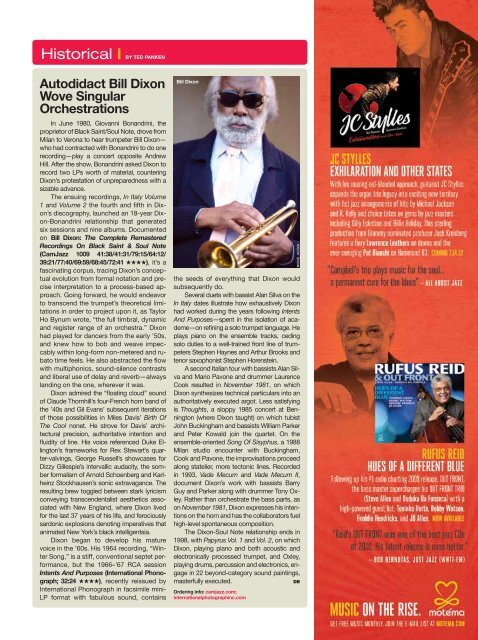Wessell Anderson Gerry Hemingway Dave Stryker John ... - Downbeat
Wessell Anderson Gerry Hemingway Dave Stryker John ... - Downbeat
Wessell Anderson Gerry Hemingway Dave Stryker John ... - Downbeat
You also want an ePaper? Increase the reach of your titles
YUMPU automatically turns print PDFs into web optimized ePapers that Google loves.
Historical | BY TED PAnKEn<br />
Autodidact Bill Dixon<br />
Wove Singular<br />
orchestrations<br />
In June 1980, Giovanni Bonandrini, the<br />
proprietor of Black Saint/Soul Note, drove from<br />
Milan to Verona to hear trumpeter Bill Dixon—<br />
who had contracted with Bonandrini to do one<br />
recording—play a concert opposite Andrew<br />
Hill. After the show, Bonandrini asked Dixon to<br />
record two LPs worth of material, countering<br />
Dixon’s protestation of unpreparedness with a<br />
sizable advance.<br />
The ensuing recordings, In Italy Volume<br />
1 and Volume 2 the fourth and fifth in Dixon’s<br />
discography, launched an 18-year Dixon-Bonandrini<br />
relationship that generated<br />
six sessions and nine albums. Documented<br />
on Bill Dixon: The Complete Remastered<br />
Recordings On Black Saint & Soul Note<br />
(camJazz 1009 41:38/41:31/79:15/64:12/<br />
39:21/77:40/69:59/68:45/72:41 ★★★★), it’s a<br />
fascinating corpus, tracing Dixon’s conceptual<br />
evolution from formal notation and precise<br />
interpretation to a process-based approach.<br />
Going forward, he would endeavor<br />
to transcend the trumpet’s theoretical limitations<br />
in order to project upon it, as Taylor<br />
Ho Bynum wrote, “the full timbral, dynamic<br />
and register range of an orchestra.” Dixon<br />
had played for dancers from the early ’50s,<br />
and knew how to bob and weave impeccably<br />
within long-form non-metered and rubato<br />
time feels. He also abstracted the flow<br />
with multiphonics, sound-silence contrasts<br />
and liberal use of delay and reverb—always<br />
landing on the one, wherever it was.<br />
Dixon admired the “floating cloud” sound<br />
of Claude Thornhill’s four-French horn band of<br />
the ’40s and Gil Evans’ subsequent iterations<br />
of those possibilities in Miles Davis’ Birth Of<br />
The Cool nonet. He strove for Davis’ architectural<br />
precision, authoritative intention and<br />
fluidity of line. His voice referenced Duke Ellington’s<br />
frameworks for Rex Stewart’s quarter-valvings,<br />
George Russell’s showcases for<br />
Dizzy Gillespie’s intervallic audacity, the somber<br />
formalism of Arnold Schoenberg and Karlheinz<br />
Stockhausen’s sonic extravagance. The<br />
resulting brew toggled between stark lyricism<br />
conveying transcendentalist aesthetics associated<br />
with New England, where Dixon lived<br />
for the last 37 years of his life, and ferociously<br />
sardonic explosions denoting imperatives that<br />
animated New York’s black intelligentsia.<br />
Dixon began to develop his mature<br />
voice in the ’60s. His 1964 recording, “Winter<br />
Song,” is a stiff, conventional septet performance,<br />
but the 1966–’67 RCA session<br />
Intents And Purposes (international Phonograph;<br />
32:24 ★★★★), recently reissued by<br />
International Phonograph in facsimile mini-<br />
LP format with fabulous sound, contains<br />
Bill Dixon<br />
the seeds of everything that Dixon would<br />
subsequently do.<br />
Several duets with bassist Alan Silva on the<br />
In Italy dates illustrate how exhaustively Dixon<br />
had worked during the years following Intents<br />
And Purposes—spent in the isolation of academe—on<br />
refining a solo trumpet language. He<br />
plays piano on the ensemble tracks, ceding<br />
solo duties to a well-trained front line of trumpeters<br />
Stephen Haynes and Arthur Brooks and<br />
tenor saxophonist Stephen Horenstein.<br />
A second Italian tour with bassists Alan Silva<br />
and Mario Pavone and drummer Laurence<br />
Cook resulted in November 1981, on which<br />
Dixon synthesizes technical particulars into an<br />
authoritatively executed argot. Less satisfying<br />
is Thoughts, a sloppy 1985 concert at Bennington<br />
(where Dixon taught) on which tubist<br />
<strong>John</strong> Buckingham and bassists William Parker<br />
and Peter Kowald join the quartet. On the<br />
ensemble-oriented Song Of Sisyphus, a 1988<br />
Milan studio encounter with Buckingham,<br />
Cook and Pavone, the improvisations proceed<br />
along statelier, more tectonic lines. Recorded<br />
in 1993, Vade Mecum and Vade Mecum II,<br />
document Dixon’s work with bassists Barry<br />
Guy and Parker along with drummer Tony Oxley.<br />
Rather than orchestrate the bass parts, as<br />
on November 1981, Dixon expresses his intentions<br />
on the horn and has the collaborators fuel<br />
high-level spontaneous composition.<br />
The Dixon-Soul Note relationship ends in<br />
1998, with Papyrus Vol. 1 and Vol. 2, on which<br />
Dixon, playing piano and both acoustic and<br />
electronically processed trumpet, and Oxley,<br />
playing drums, percussion and electronics, engage<br />
in 22 beyond-category sound paintings,<br />
masterfully executed. DB<br />
ordering info: camjazz.com;<br />
internationalphotographinc.com<br />
michael JacKson<br />
JULY 2011 DOWNBEAT 63

















